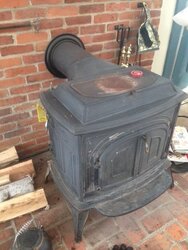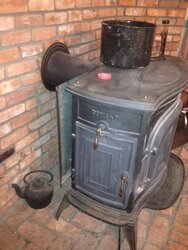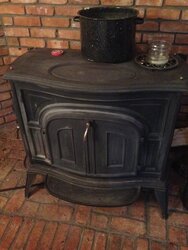Hi all, not a woodstove expert but been browsing these forums for a while and decided to ask for advice on my current situation.
I recently bought a 2400 sq/ft 200 year old brick farmhouse. It came with 2 woodstoves which I have been using as my primary heat source. Both are Vermont castings, one defiant, and one vigilant. The vigilant works great and is used to heat a living room, bathroom and small bedroom. Its easy to use, not very smokey and can easily run for hours in the 300 range (stove top temp).
The defiant is a different story. I know the stove needs some work, gaskets, seals around doors, etc. No updraft problems but when i run in horizontal (handle down?) mode it gets very smokey. The stove other than that runs ok. in vertical mode (handle horizontal) stove runs great and can get up the 500+ range. It runs a little cooler surface temp but generaly around the 300 degree range. The burn time is not as long though.
For both stoves I have an 8 inch pipe that goes directly into the chimney behind the stove. (brick with new liner in 2013)
I plan on living in this house for a long time and I want to make the right investment. I know that there are tons of insulation and gaps that need to be filled to make the house feel warmer (home energy audit being done soon hopefully) but I am curious if replacing the defiant is the right move. The first thing that comes to mind is the ideal steel. For the price I could replace both stoves over the course of a few years. With the layout of the house (L shaped) i think 2 stoves is the way to go.
So I guess my question is: Am I thinking correctly that a more efficient stove like an ideal steel is the way to go? Will that give me longer burn times and more heat than the older defiant? Will the ideal steel have any problems with my chimney setup?(8" pipe that goes 14" directly into brick chimney 29" from floor approximately 20' high) Will the ideal steel or similar more modern stove use less wood for more heat? Money is definately a priority for us, since there are lots of other projects that need to be done. But I do want my family to be as warm as possible for as little wood as possible and as safe as possible.
Thanks again, sorry if I left out any important information.
I recently bought a 2400 sq/ft 200 year old brick farmhouse. It came with 2 woodstoves which I have been using as my primary heat source. Both are Vermont castings, one defiant, and one vigilant. The vigilant works great and is used to heat a living room, bathroom and small bedroom. Its easy to use, not very smokey and can easily run for hours in the 300 range (stove top temp).
The defiant is a different story. I know the stove needs some work, gaskets, seals around doors, etc. No updraft problems but when i run in horizontal (handle down?) mode it gets very smokey. The stove other than that runs ok. in vertical mode (handle horizontal) stove runs great and can get up the 500+ range. It runs a little cooler surface temp but generaly around the 300 degree range. The burn time is not as long though.
For both stoves I have an 8 inch pipe that goes directly into the chimney behind the stove. (brick with new liner in 2013)
I plan on living in this house for a long time and I want to make the right investment. I know that there are tons of insulation and gaps that need to be filled to make the house feel warmer (home energy audit being done soon hopefully) but I am curious if replacing the defiant is the right move. The first thing that comes to mind is the ideal steel. For the price I could replace both stoves over the course of a few years. With the layout of the house (L shaped) i think 2 stoves is the way to go.
So I guess my question is: Am I thinking correctly that a more efficient stove like an ideal steel is the way to go? Will that give me longer burn times and more heat than the older defiant? Will the ideal steel have any problems with my chimney setup?(8" pipe that goes 14" directly into brick chimney 29" from floor approximately 20' high) Will the ideal steel or similar more modern stove use less wood for more heat? Money is definately a priority for us, since there are lots of other projects that need to be done. But I do want my family to be as warm as possible for as little wood as possible and as safe as possible.
Thanks again, sorry if I left out any important information.




